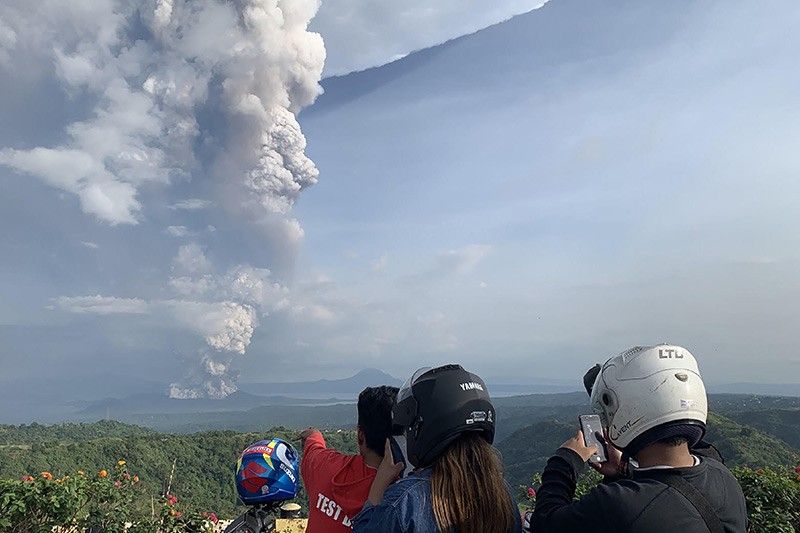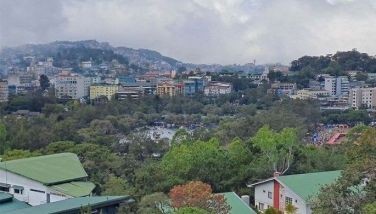Thousands flee their homes as Taal Volcano rumbles

MANILA, Philippines — Taal Volcano spewed a massive cloud of ash into the sky on Sunday, forcing the precautionary evacuation of thousands of residents, authorities said.
Government seismologists recorded magma moving towards the crater of Taal, one of the country's most active volcanoes located 65 kilometers (40 miles) south of Manila.
That increases the chances of an eruption that could happen "within days to within weeks" if such activity continues, Renato Solidum, chief of the Philippine Institute of Volcanology and Seismology, told AFP.
Taal's last eruption was in 1977, he added.
READ: Phivolcs raises alert level to 3 as Taal Volcano spews kilometer-high plumes
A kilometer-high column of ash was visible and several volcanic tremors were felt within the vicinity of the volcano, which is popular among tourists for its scenic view.
The local disaster office said it had evacuated over 2,000 residents living on the volcanic island, which lies inside a bigger lake formed by previous volcanic activity.
READ: Walang Pasok: Canceled classes for January 13, 2020 due to Taal Volcano's unrest
Solidum said officials will also order the evacuation of people living on another island nearby if the situation worsens.
Earthquakes and volcanic activity are not uncommon in the Philippines due to its position on the Pacific "Ring of Fire," where tectonic plates collide deep below the Earth's surface.
In January 2018, Mount Mayon displaced tens of thousands of people after spewing millions of tonnes of ash, rocks, and lava in the central Bicol region.
WATCH: Taal Volcano spews plumes 100 meters high after phreatic eruption
Get updates as Phivolcs issues warnings over activity in Taal Volcano. (Main photo by Philstar.com/Rosette Adel)
The Philippine Institute of Volcanology and Seismology issues a notice reporting an increased and continuous degassing activity from Taal Volcano.
In its 6 p.m. advisory, Phivolcs says the sulfur dioxide emission from the main crater reached 9762 tonnes per day. This was the higher recorded this year.
Phivolcs adds that there was no smog or vog observed. — Rosette Adel
The Philippine Institute of Volcanology and Seismology says Taal Volcano is still under Alert Level 1.
In an update on Wednesday, its says that the daily sulfur dioxide emissions (SO2) reached 2887 tonnes / day (06 October 2023).
Phivolcs also observes upwelling of hot volcanic fluids in the Main Crater Lake. — Rosette Adel
The Philippine Institute of Volcanology and Seismology reports that Taal Volcano's daily sulfur dioxide emissions (SO2) reached 2887 tonnes.
It observes upwelling of hot volcanic fluids in the Main Crater Lake as well as volcanic smog or vog.
The volcano's emissions are also 2400 meters tall. — Rosette Adel
The Philippine Institute of Volcanology and Seismology releases time-lapse snapshots of degassing activity from the Taal Main Crater and volcanic smog or vog formation on Sunday.
These were taken from 5:45 a.m. to 11:42 a.m. by the Mt. Macolot, Cuenca, Batangas station (VTCU) IP Camera.
LOOK: Time-lapse snapshots of degassing activity from the Taal Main Crater and volcanic smog or vog formation taken from 05:45 AM to 11:42 AM today, 8 October 2023 by the Mt. Macolot, Cuenca, Batangas station (VTCU) IP Camera. pic.twitter.com/jp48R1IZQy
— PHIVOLCS-DOST (@phivolcs_dost) October 8, 2023
— Rosette Adel
The Philippine Institute of Volcanology and Seismology records daily sulfur dioxide emissions that reached 2730 tonnes / day (22 September 2023).
It also observes upwelling of hot volcanic fluids in the Main Crater Lake and observed VOG.
Phivolcs adds that there is a ong-term deflation of the Taal Caldera; short-term inflation of the northern flanks of the Taal Volcano Island.
- Latest
- Trending
































